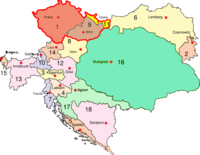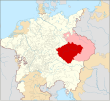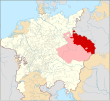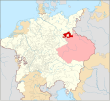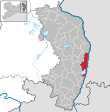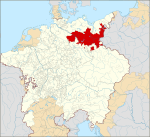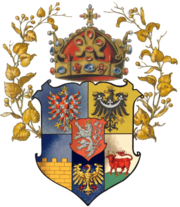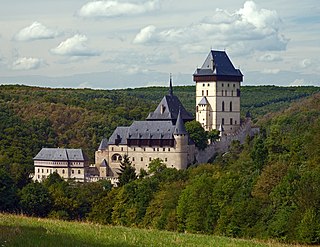
Bohemia is the westernmost and largest historical region of the Czech Republic. Bohemia can also refer to a wider area consisting of the historical Lands of the Bohemian Crown ruled by the Bohemian kings, including Moravia and Czech Silesia, in which case the smaller region is referred to as Bohemia proper as a means of distinction.
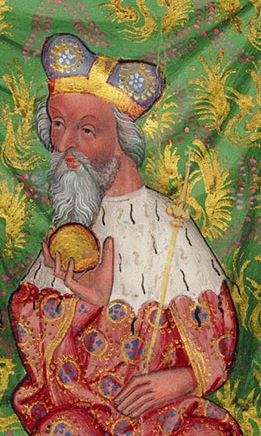
Jobst of Moravia, a member of the House of Luxembourg, was Margrave of Moravia from 1375, Duke of Luxembourg and Elector of Brandenburg from 1388 as well as elected King of Germany from 1410 until his death. Jobst was an ambitious and versatile ruler, who in the early 15th century dominated the ongoing struggles within the Luxembourg dynasty and around the German throne.

Charles IV, also known as Charles of Luxembourg, born Wenceslaus, was Holy Roman Emperor from 1355 until his death in 1378. He was elected King of Germany in 1346 and became King of Bohemia that same year. He was a member of the House of Luxembourg from his father's side and the Bohemian House of Přemyslid from his mother's side; he emphasized the latter due to his lifelong affinity for the Bohemian side of his inheritance, and also because his direct ancestors in the Přemyslid line included two saints.

The history of the Czech lands – an area roughly corresponding to the present-day Czech Republic – starts approximately 800,000 years BCE. A simple chopper from that age was discovered at the Red Hill archeological site in Brno. Many different primitive cultures left their traces throughout the Stone Age, which lasted approximately until 2000 BCE. The most widely known culture present in the Czech lands during the pre-historical era is the Únětice Culture, leaving traces for about five centuries from the end of the Stone Age to the start of the Bronze Age. Celts – who came during the 5th century BCE – are the first people known by name. One of the Celtic tribes were the Boii (plural), who gave the Czech lands their first name Boiohaemum – Latin for the Land of Boii. Before the beginning of the Common Era the Celts were mostly pushed out by Germanic tribes. The most notable of those tribes were the Marcomanni and traces of their wars with the Roman Empire were left in south Moravia.

Ottokar II, the Iron and Golden King, was a member of the Přemyslid dynasty who reigned as King of Bohemia from 1253 until his death in 1278. He also held the titles of Margrave of Moravia from 1247, Duke of Austria from 1251, and Duke of Styria from 1260, as well as Duke of Carinthia and landgrave of Carniola from 1269.

The Czech lands or the Bohemian lands is a historical-geographical term that, in a historical context, refers the three historical regions of Bohemia, Moravia, and Czech Silesia together before Czechoslovakia and later the Czech Republic were formed. Together the three have formed the Czech part of Czechoslovakia since 1918 and the Czech Republic since 1 January 1993.

The Duchy of Bohemia, also later referred to in English as the Czech Duchy, was a monarchy and a principality of the Holy Roman Empire in Central Europe during the Early and High Middle Ages. It was formed around 870 by Czechs as part of the Great Moravian realm. Bohemia separated from disintegrating Great Moravia after Duke Spytihněv swore fealty to the East Frankish king Arnulf in 895.

The Habsburg monarchy, also known as Habsburg Empire, was the collection of empires, kingdoms, duchies, counties and other polities that were ruled by the House of Habsburg. From the 18th century it is also referred to as the Danubian monarchy or the Austrian monarchy.

The Kingdom of Bohemia, sometimes referenced in English literature as the Czech Kingdom, was a medieval and early modern monarchy in Central Europe. It was the predecessor of the modern Czech Republic.

The Duchy of Silesia with its capital at Wrocław was a medieval duchy located in the historic Silesian region of Poland. Soon after it was formed under the Piast dynasty in 1138, it fragmented into various Silesian duchies. In 1327, the remaining Duchy of Wrocław as well as most other duchies ruled by the Silesian Piasts passed to the Kingdom of Bohemia as Duchies of Silesia. The acquisition was completed when King Casimir III the Great of Poland renounced his rights to Silesia in the 1335 Treaty of Trentschin.
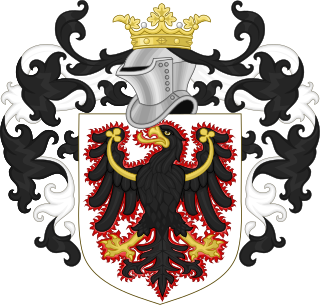
The Přemyslid dynasty or House of Přemysl was a Bohemian royal dynasty that reigned in the Duchy of Bohemia and later Kingdom of Bohemia and Margraviate of Moravia, as well as in parts of Poland, Hungary and Austria.

The House of Luxembourg or Luxembourg dynasty was a royal family of the Holy Roman Empire in the Late Middle Ages, whose members between 1308 and 1437 ruled as kings of Germany and Holy Roman emperors as well as kings of Bohemia, Hungary and Croatia. Their rule was twice interrupted by the rival House of Wittelsbach. The family takes its name from its ancestral county of Luxembourg which they continued to hold.

The Duchy of Austria was a medieval principality of the Holy Roman Empire, established in 1156 by the Privilegium Minus, when the Margraviate of Austria (Ostarrîchi) was detached from Bavaria and elevated to a duchy in its own right. After the ruling dukes of the House of Babenberg became extinct in male line, there was as much as three decades of rivalry on inheritance and rulership, until the German king Rudolf I took over the dominion as the first monarch of the Habsburg dynasty in 1276. Thereafter, Austria became the patrimony and ancestral homeland of the dynasty and the nucleus of the Habsburg monarchy. In 1453, the archducal title of the Austrian rulers, invented by Duke Rudolf IV in the forged Privilegium Maius of 1359, was officially acknowledged by the Habsburg emperor Frederick III.
The history of Moravia, one of the Czech lands, is diverse and characterized by many periods of foreign governance.

The Principality of Opava or Duchy of Troppau was a historic territory split off from the Margraviate of Moravia before 1269 by King Ottokar II of Bohemia to provide for his natural son, Nicholas I. The Opava territory thus had not been part of the original Polish Duchy of Silesia in 1138, and was first ruled by an illegitimate offshoot of the Bohemian Přemyslid dynasty, not by the Silesian Piasts like many of the neighbouring Silesian duchies. Its capital was Opava (Troppau) in the modern-day Czech Republic.

The Treaty of Trentschin was concluded on 24 August 1335 between King Casimir III of Poland and King John of Bohemia together with his son Margrave Charles IV. The agreement was reached by the agency of Casimir's brother-in-law King Charles I of Hungary and signed at Trencsén Castle in the Kingdom of Hungary. It initiated the transfer of suzerainty over the former Polish province of Silesia to the Kingdom of Bohemia, whereafter the Duchies of Silesia were incorporated into the Bohemian Crown.

The Duchy of Krnov or Duchy of Jägerndorf was one of the Duchies of Silesia, which in 1377 emerged from the Duchy of Troppau (Opava), itself a fief of the Bohemian Crown. Its capital was at Krnov in the present-day Czech Republic.

The Margraviate of Moravia was one of the Lands of the Bohemian Crown within the Holy Roman Empire and then Austria-Hungary, existing from 1182 to 1918. It was officially administered by a margrave in cooperation with a provincial diet. It was variously a de facto independent state, and also subject to the Duchy, later the Kingdom of Bohemia. It comprised the historical region called Moravia, which lies within the present-day Czech Republic.

King John's eldest son Charles IV was elected King of the Romans in 1346 and succeeded his father as King of Bohemia in the same year. Charles IV created the Bohemian Crown lands on the foundation of the original Czech lands ruled by the Přemyslid dynasty until 1306, together with the incorporated provinces in 1348. By linking the territories, the interconnection of crown lands thus no more belonged to a king or a dynasty but to the Bohemian monarchy itself, symbolically personalized by the Crown of Saint Wenceslas.




